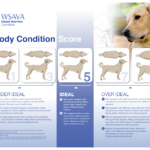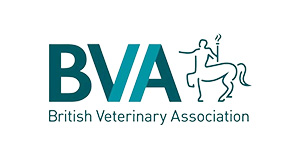Canine and Feline Obesity
While we all love giving our pets treats and food, canine and feline obesity is a growing problem in our pets. With so many pets becoming overweight, it can make it appear the norm and yet weight issues can have serious impacts on our pet’s health and longevity.
But how do I identify an overweight dog or cat?
Dogs and cats are given a score out of 9 on a sliding scale. Score 1-3 is underweight, score 4-5 is an ideal weight, and 6-9 is overweight – with the top end of this being obese animals.
On dogs and cats, first look at them from above. You should be able to see a defined waist. Run your hands along their sides – are you able to feel the ribs with a light touch with the skin moving freely over the ribs? Next run your hands along their back – can you feel the spine and hip bones without seeing them? Under their tummy, does it go in? (i.e. not bulge out). Finally, check the base of the tail. There should not be any fat build ups.
If you are not seeing a waist, have a pet with a tummy hanging down, or are struggling to feel definition on ribs/spine or hips, then your pet is likely overweight. While different breeds vary in shape, these basic rules apply to all.
So, what are the implications for our pets?
Increased weight puts more strain on the joints, leading to an increased risk of arthritis (and weight loss is one of the first things we aim for in pets showing signs of arthritis). It can also increase the risk of cancer, development of hormonal issues such as diabetes, heart issues, high blood pressure (hypertension), urinary issues, and spinal issues.
Obesity can also cause breathing problems which in turn can make things like exercising in warm weather or surgical anesthesia riskier. This is especially true in brachycephalic breeds; it is important to keep these dogs trim.
In 2021 a study found that Pugs, Beagles, Golden retrievers, English Springer spaniels, Labradors, Cavalier King Charles spaniels and Cocker Spaniels are at an increased risk of being overweight. While neutering does not cause weight gain, it will lower your pet’s metabolism meaning they require fewer calories.
Indoor cats are more at risk of obesity due to their sedentary lifestyle. However, obesity can again predispose to health conditions listed above.
To lose weight, the main thing is to watch what they eat. Start by measuring out exactly what they eat, including treats – these add up! Then look to reduce portion sizes by 10% for slow, steady weight loss.
With treats it is important to think of quantities – a tin of tuna for a cat is over 100 calories, over a third of their required intake and equivalent to eating 35 chicken nuggets! An ounce of cheese can be the same as a burger for a 10kg dog. We all like to give our dogs treats, but if you want them to lose weight it needs to be cut down and switched to low calorie alternatives.
Worried about your pet’s weight?
If you think your pet is overweight, we run nurse weight clinics here and can provide guidance on how to help them slim down. Our nurses can look at what you are currently feeding and make suggestions about how to get the weight down in a sensible manner. Exercise and play can also be increased in a steady manner if appropriate (i.e. no underlying health conditions). Slow or puzzle feeders can also help spread mealtimes and burn a few extra calories at the same time.













